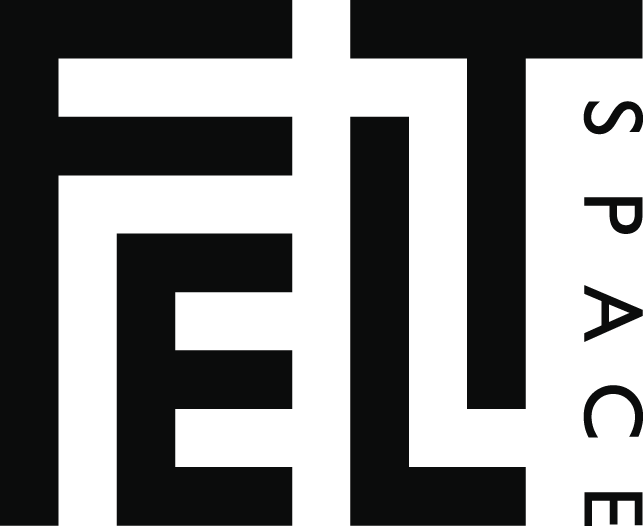CAST NO SHADOW / ROSE TINTED / THE VILOET HOUR - MAY 2017
Artists: Mia Van Den Bos / Callum McGrath / Elise Bonato
Author - Stephanie Daughtry
Artificial: made or constructed by human skill, esp. in imitation of, or as a substitute for, something which is made or occurs naturally; man-made.
A pink neon glare seeps through the entrance to the Back Gallery of FELTspace. Drawing us in like moths to a flame, the light – despite its artificial hue – peaks an irrepressible interest. At first glance the small room consists only of this bright sticky glow. We look down, searching for its source (a fluorescent bulb at the foot of the wall) then turn back the way we came through. Curiously small and placed above the eye-line, a slow-moving pink-washed pan across a lush Australian landscape is projected directly onto the wall facing the Front Gallery. To view Callum McGrath’s video installation, Rose Tinted, we are forced to turn back onto ourselves.
The work’s title introduces a complex sincerity to the piece. Rose-tinted glasses traditionally glaze over moments passed with warm sepia-tones. Here “rose-tinted” is applied literally and liberally. Using colour and symbolism as tools to cut through knee-jerk reactions of the subconscious, the film subverts the tall proud eucalypts and dense tropical forests of Romantic Australiana. Slow and meditative, yet blaring in sensory overload, Rose Tinted looks out on the external but seems to say more about us as viewers than it unlocks any mystery of the material. Exposing perception as the artificial construct that it is, the piece poses questions regarding where truth ends and objectivity begins in the construct of the personal. The application of synthetic layering makes us look closer, and with greater curiosity. Responding to the film’s minute pace, we can begin to apply nuance to the over-saturated. A contemplative perception fostered by the passing of time.
Exiting the transportive space of McGrath’s work into the Front Gallery, we are caught by a blare of images in Mia Van Den Bos’ Cast No Shadow. Tackling the intimate connection we have to iPhone screens, Van Den Bos transmits her personal screen-shot gallery onto actual gallery walls. Here, the unremarkable habits of our ‘digital age’ are held up for scrutiny and surveillance. Muted streaks of anger and violence channelled through post-capitalist websites are evoked through bold text and blocks of bright red. Yet pervading the work is a sense of openness and fun - like digital memes taking material form, and objects push passed the confines of 2D to emerge as physical objects within space. Small egg sculptures are a recurring feature, perhaps as an antithesis to the artificiality of the digital, organically and asymmetrically reproduced. Intimately fitting the curve of a cupped palm, the eggs have weight and substance that ephemeral digital content doesn’t. Perhaps the eggs signify organic reproduction, and the way the universe keeps redefining itself. Or perhaps the artist simply likes eggs. In her own words “I just thought they were funny”, a reminder not to take ourselves so seriously.
In the centre of the room is a scatter of shredded paper encased by a thin sheet of plastic; Ephemera preserved by the longevity of the screen. There is a consistent suggestion that while the images we capture should probably be transient, they instead clog the drains of digital storage space. Van Den Bos encourages us to think about the actual weight digital space places on the personal. Furthermore, how much thought is given to the exploitative technologies which take advantage of these intimate online fascinations? In her references to Silicon Valley tech workers, further explored in Jonno Revanche’s accompanying written piece, threads evoking fun, mystery, and a sense of pervading threat are carefully interwoven into a complex tapestry on textured plastic.
Actively fusing the barriers between the physical and digital, The Violet Hour by Elise Bonato explores the liminal space in-between both worlds through her FELTdark film. Bonato invokes gestures that can only be embodied through the physical presence of self, in space, through movement and experience, yet as viewers we see these explorations through an edited film construct. Her veiled, statuesque figure, creates evocative tableaus in local urban environments, flickering eerily between them on an indeterminate loop. At first content to be a symbiotic Spector of space, with time her movements become more isolated, and she becomes less a complementary sculptural feature and more of an actively disparate entity. Using the gallery itself as artefact, Bonato explores the notion that perhaps the greatest imposters of space are human beings themselves. Bonato opens the door to something spiritual and otherworldly (does the digital realm simply give substance to the ethereal?), and, in her own words is concerned solely with how the work makes you feel.
Each of the works at FELTspace this month scrutinise daily artefacts, second guessing the assurance of our footing. Through engaging in a fascination with (and subjugation to) the artificial, they encourage closer inspection, and an enhanced degree of curiosity, critique and/or joy. In a trail of digital story-telling it is difficult to say where our shadows fall, and even more difficult to say what that might mean. But it’s worth asking the question anyway, attempting to cut through the blur of information saturation to reach moments of clarity.
